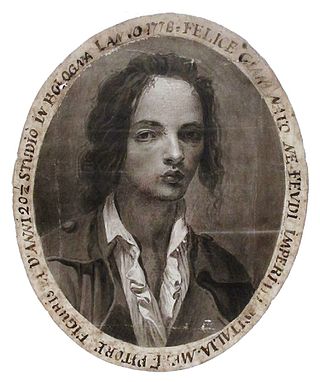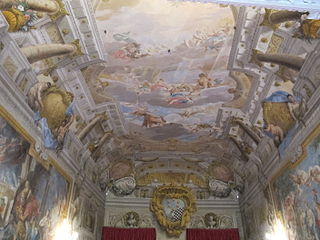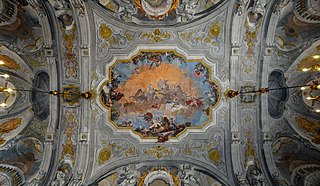Related Research Articles

Carlo Cignani was an Italian painter. His innovative style referred to as his 'new manner' introduced a reflective, intimate mood of painting and presaged the later pictures of Guido Reni and Guercino, as well as those of Simone Cantarini. This gentle manner marked a break with the more energetic style of earlier Bolognese classicism of the Bolognese School of painting.

Domenico Maria Canuti was an Italian painter of the Baroque period, active mainly in Bologna and Rome. He was a major painter of fresco decorations. His ceiling decorations showed a mix of Bolognese and Roman influences.

Ferdinando Galli-Bibiena, surname also spelled Galli da Bibiena or Bibbiena, was an Italian Baroque-era architect, designer, and painter.

The Galli–Bibiena family, or Galli da Bibiena, was a family of Italian artists of the 17th and 18th centuries, including:

Francesco Galli, called Francesco da Bibiena, or da Bibbiena (1659-1739) was a member of the theatrical Galli da Bibiena family and younger brother of Ferdinando Galli.

Felice Giani was an Italian painter of the Neoclassic style. His grand manner subjects often included Greco-Roman allusions or themes.

Giacomo Parolini was an Italian painter of the Baroque period, mainly active in Ferrara.

Marcantonio Chiarini was an Italian painter of the late-Baroque period. Born near Bologna, he trained with Francesco Quaino and Domenico Santi. He painted scenography for plays as well as quadratura in which Sigismondo Caula inserted figures. Active in Bologna and Milan, he also painted the quadratura of the Palazzo Mansi in Lucca, for which Giovanni Gioseffo dal Sole painted the main frescoes. Chiarini was employed by the architect Johann Lukas von Hildebrandt in the fresco decoration of the upper and lower Belvedere palaces near Vienna, work shared with Martino Altomonte, Gaetano Fanti, and Carlo Carlone.

Agostino Mitelli was an Italian painter of the Baroque period and best known as a fresco painter of quadratura or illusionistic perspectival architectural frameworks.
Events from the year 1678 in art.
Giuseppe Natali (1652–1722) was an Italian painter of the Baroque period and active mainly in Cremona and Lombardy.

Luigi Pellegrini Scaramuccia (1616–1680) was an Italian painter and artist biographer of the Baroque period. He was a pupil, along with Giovanni Domenico Cerrini of the painter Guido Reni.

Tommaso Aldrovandini was an Italian painter of the Baroque period. He mainly painted perspective views and architectural subjects (quadratura), in which the figures were painted by Marcantonio Franceschini and Carlo Cignani. He decorated churches, palaces, and theaters in Forlì, Verona, Venice, Parma, Turin, Ferrara, and Genoa, and especially in his native Bologna. Among his pupils was Giovanni Benedetto Paolazzi.
Baldassare Bianchi was an Italian painter of the Baroque period.
Antonio Pachera was an Italian painter, born in Verona.

Francesco Lorenzi was an Italian painter of the late Baroque period.

Stefano Orlandi was an Italian painter, active mainly in Bologna in the architectural perspective painting. He is known for painting fanciful architectural canvases, known as Capricci.
Giovanni Battista Alberoni was an Italian painter, scenic designer, and engraver of the late-Baroque period, active in Bologna and Turin, mainly in quadratura painting. He died on New Years Eve 1784 at the age of 81.

Giovanni Battista Crosato was an Italian painter of quadratura, active in the 18th century in Piedmont.
Pietro Scandellari (1711–1789) was an Italian painter and scenic designer.
References
- Zannandreis, Diego (1891). Giuseppe Biadego (ed.). Le vite dei pittori, scultori e architetti veronesi. Verona: Stabilimento Tipo-Litografico G. Franchini. pp. 424–426.